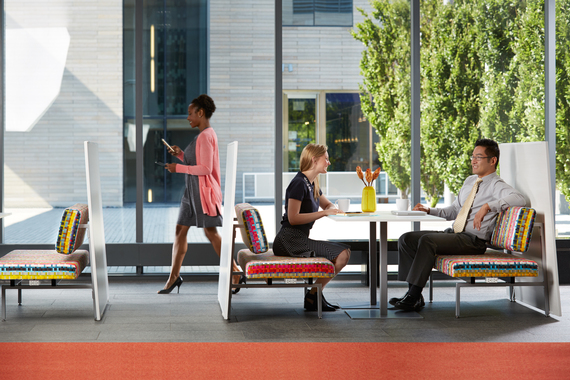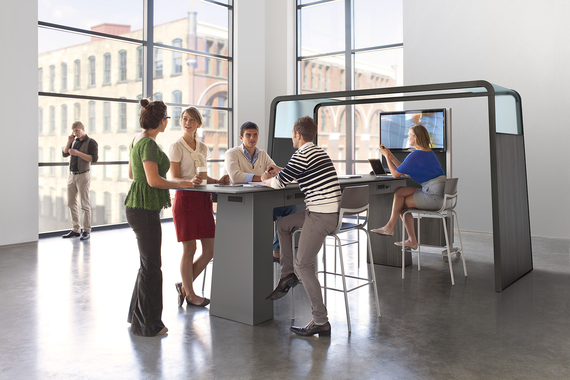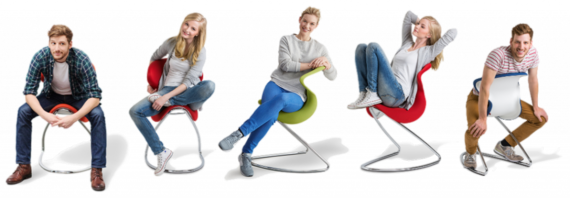As technology frees us up from a set work location, workplace ergonomics are starting to look a little different. While product designers once had to optimize one set work location for optimal ergonomic postures, technology now is driving us to different postures in many places throughout the workplace and beyond.
NeoCon 2015 could have been summarized as, "The Year the Skirt Died." A far cry from the "modesty panels" of years' past, showrooms and booths seemed to be filled with extra low lounge seating (try sitting or gracefully getting up from that in a skirt!), movement-inducing saddle (read: straddle) chairs, and sofas fit for a living room. Everything appears to be getting more casual, down to the office attire. I recently was invited to present at a meeting with a dress code titled "business careful," which meant jeans and a blazer. So what does all of this mean for the product design of the future?
In an interview with Joey Ruiter, an award-winning and globally acclaimed product designer, about what this means for the future of product design in the contract furniture industry, Ruiter said, "I think you are spot on with your summary. There is a level of not intimacy but relaxation that comes with some of these new postures. You hang out on a couch with someone who you typically have a different relationship with than a coworker. You shift your body language and posture. When those pieces arrive to the office some people don't like it. We are introducing language that is new to the workplace, which creates new challenges."
This new workplace language could explain why the furniture industry is struggling to come up with meaningful new product propositions. These new postures are redefining cultural norms, which still are largely undecided and can be very different for different cultures and organizations. Ruiter says, "The postures we sit ourselves in give us feelings and emotions and create deeply seeded physical responses. Each posture has a different -and purposeful- need that it is meeting." Ruiter helps by defining five postures in the workplace that will define the future physical workplace.
Sitting
Clearly the most proliferate posture of years' past, sitting obviously still has a place in the office of the future, but with headlines such as "sitting is the new smoking", traditional seating postures may be less ubiquitous than years past. Ruiter says, "When you are sitting you are compressed. Your circulation drops and you are relatively stagnant. When sitting in a meeting or conference room setting, it is easier for people to fidget around, put their legs up, or worse, if you are a more anxious personality. There is a clear driver and a passenger in a seated setting." Full disclosure: Ruiter admits he prefers to work (and meet) standing up whenever possible.
Standing
Standing height increasingly has been used in individual work settings in recent years. It also is increasing as a height for meeting settings much more so than in the past. Ruiter says, "I am really a fan of standing meetings because it creates a setting where people can come and go without a threshold change and posture change. Through standing height furniture, we are postured more communally and positioned as more equal. Ergonomically, this overcomes some of personal issues in group settings. If you had to step out for five seconds there's little disruption vs. wheeling a chair back, swiveling, getting up and walking out."
Lounge posture is one of the newer postures to hit the workplace and as it becomes more prevalent, it could be argued that it is a cause of some of the postural and cultural confusion. Ruiter says, "It provides a great place to read, reflect, chill out or just take a moment to breathe; and that is important in today's workplace. I just don't see it as very engaging and active. There are physical postures that signal how we are feeling toward someone. Leaning back 17-18 degrees in a lounge posture with legs sort of open says I am stepping back and if not careful can suggest I am not interested. In contrast, it also says I am relaxed with you and we can have this dialogue." Ruiter's point is that while useful, we must be mindful of HOW we expect spaces with this posture to be used. Workplace postures echo basic psychology, and our physical body language has deeply seeded unspoken messages that rapidly cannot be overcome.
Walking
Walking meetings, and movement in general definitely will become a mainstay of workplace "postures" (if we can count it as that) as workplace wellness takes hold in increasing ways. Ruiter says, "I recently designed a couple of pieces for this. I was doing research for a company and we came up with ten ridiculous things that might make sense for these postures." The thing about moving meetings is: it's much less about furniture and much more about culture and driving behavior.
Leaning
As we are freed up from a set work location and encouraged to move throughout the day to collaborate and interact, leaning or propping is becoming a prevalent, yet purposefully informal posture. Ruiter says, "We have been doing it, we just don't recognize it and don't have pieces designed for it. Perhaps we shouldn't. We lean on a big rock, a log, stairs, a wall or a railing. These objects aren't designed for meeting spaces but draw people toward them."
As we look at these last two growing "postures" for the work environment, what do they mean for furniture? Ruiter says, "I feel like the market is pushing for something new, and I don't know if it exists." In the past, we went to the office because there were items that were unaffordable to obtain for a home office such as a copy machine, scanners, etc. Now all of these items are available, affordable and easily obtained in home offices at affordable prices. Ruiter says, "The best analogy I can create is the gym membership. Sometimes people don't have the space or can't afford specialized gym equipment at home. The popularity of gyms still is growing because of the social aspect, or the community. The pressure helps you work better. The community pushes you harder. This is the reason I don't see the office going away completely. I see more value in it than ever. What the industry needs are pieces that you absolutely can only get there. And the things you only can get there now are community, pressure and one-on-one contact."
We now have the spaces to create these postures but we need multiple types of spaces for different types of people. No one setting fits all bills. In general, people are becoming more aware of what is valuable in every sense of their lives. Additionally, the idea of valuing experiences over things is not limited to younger generations. Ruiter closes us with this thought, "In general, we are thinking more about what we value instead of the woodgrain corner office that we thought we deserved. I'd rather spend $300 on a concert experience than on a physical thing. I hope our industry remains thoughtful about not just making stuff to make stuff. Culturally, we just don't need as much stuff around us to do the work that we are doing. I don't know if the industry has caught up to that, but it will."
This article originally published in Workplaces Magazine on April 4, 2016 and can be found at this link. It is republished here with permission.

